|
|
cOmE JoIn LeaRn in Japanese LaNgUaGe...(merged with lovelee)
[Copy link]
|
|
|
susah nak cakap lerrr..camner nak bagi senang hafal alphabet..
sebab saza blajar japanese..8 jam sehari..jadik senang lerr ingat..
yg pasal words plak...mula diajar yg senang,mudah..
cam,cikgu,kerusi,meja,kucing,parents,.......
pass tu baru belajar yg words susah...sambil diajar grammar...
ingat lagik masa mula belajar japanese..
ya allah...bayangkan cam budak tadika baru belajar..
walaupun dah blajar japanese 2 tahun kat UTM,KL
masa first sampai Jepun...sepatah haram tak reti nak cakap..
adoiiii...maybe tak banyakkan latihan perbualan lam kelas..
kat Jepun pun sama cam Malaysia jugak..ader 'bahasa pasar'
jadik apa yg dipelajari di UTM,KL(diajar bahasa Jepun btull..)
tak digunakan langsung lam perbualan ngan kawan2..
lagi satu...kat sini pun ader longhat jugak...
masa mula2 tak paham langsung...skang dah ok..
sofia..
kalo nak tanya pasal Jepun pun bleh..
cam..org Jepun camner..guys camner...budaya..
saza akan jawab selagi saza tahu..
kalo tak tahu..nanti saza tanya kawan japanese saza.. |
|
|
|
|
|
|
|
|
|
sofia This user has been deleted
|
|
saza study kat jepun berapa lama? ada tak gi visit tpt2 yg best kat jepun. ceritalah sikit tpt2 yg famous kat jepun. |
|
|
|
|
|
|
|
|
|
|
|
dah study kat jepun...nak masuk 5 tahun..
seluruh Jepun saza dah pi...kecuali Okinawa..
kalo tempat famous bagi pelancong mestilah Kyoto..
Kyoto adalah bandar lama bagi Jepun...temple2 lama masih ader lagik..
Disneyland,Disneysea..Universal Studio Japan..taman tema paling popular..
nak paste gambar2 tempat yg saza dah gi..
tapi sumer dah bawak balik mesia..
akhir bulan 10..saza plan nak gi Universal Studio Japan..kali ke 2 pergi..
nanti saza tangkap gambar banyak2 paste kat sinih...
sofia mesti tahu pasal "geisha" kan..
geisha masih wujud lagik walaupun Jepun dah moden.. |
|
|
|
|
|
|
|
|
|
sofia This user has been deleted
|
oh...saza still kat jepun, ingatkan dah balik msia for good.
lama lagi ker nak habis?
mesti bestkan boleh gi visit cool places kat sana.
kat sana kalau holiday lama ker? boleh jer visit macam2 places
jarang balik msia ya masa cuti?
geisha yg wujud tu mesti pun dah moden jugak ya?
diaorg still pakai kimono lagi ker kat jepun? or only masa official function? |
|
|
|
|
|
|
|
|
|
|
|
insya-allah..kalo di izikan tuhan..kalo boleh nak habiskan study sampai tahun depan bln march..
kat sini kalo cuti musim bunga..sebulan(march)
cuti musim panas..2 bulan..(Aug,Sept)
cuti musim sejuk..2 minggu jekkk..(Dec)
saza balik msia..setahun sekali..jekkk..
amalan dan budaya geisha still lagik cam dulu..
pakai kimono..layan pelanggan minum sake(japanese alkohol)
pakai kimono..???apa maksud sofia..??
sumer wanita pakai kimono ker..???
masa mula2 saza pun ingat sumer wanita jepun pakai kimono..
sampai jepun..diorang tak pakai pun..
tak macam di msia..kebanyakannya still lagik pakai baju kurung..
cara pemakaian kimono..susah sgt..sebab tu ader kelas khas untuk cara2 pakai kimono..
skang wanita jepun dah moden seiring dgn negaranya yg pesat dan moden..
jadik diorang dah tak pakai lagik kimono kecuali graduation day,upacara kematian(kimono warna hitam=melambangkan kesuraman,malang,musibah),perkahwinan..
hahahahah...yg paling saza nak gelak..
masa hidup..kebanyakan japanese tak percaya tuhan lebih2 lagi belia muda..tapi bila bab mati..upacara buddha di jlnkan..
bab kawin pun sama..mengaku buddha tapi kawin kat chapel siap ada paderi lagik |
|
|
|
|
|
|
|
|
|
sofia This user has been deleted
|
sorrylah lambat sikit reply...
modem rosak dah few days ....
ni baru beli modem baru 
saza study apa kat jepun?
my cousin pun study kat jepun.
dia dah balik sini dah setahun lebih
kalau tak silap dia ambik international economics
kat jepun kan ada banyak patung2...
patung2 tu aper? tuhan dia ker or diaorg ni memang minat sgt kat patung?
8tv kat msia ader tunjuk japanese game show--> pachinko?
tu kira game judi ker? |
|
|
|
|
|
|
|
|
|
|
|
a'ah...pachinko ker...panchiko....
ape ape laaa....glamer ah game nih....best ker...???
teringin nak main....
rasernyer...majority manga yg kiter bacer...mesti selit diorang main pachinko...cam slam dunk ngan yuyu hakusho....dlm drama pun ader....
huwaaaa...best nyerrr dpt gi jepun..
aku pun nak gi gak.....
omoshiroi..... |
|
|
|
|
|
|
|
|
|
|
|
Masa ni boku no shiawase nan desu <---- ape maksud nih...
shiawase tuh means bahagia ek.....
cam ne nak hafal kanji...??? susah gilerrr~~(muzukashii....)
cam ne nak cakap susah gilerrr....
tottemo muzukashi....??? taihen plak cam ne...??
pas tu..aku slalu dengar diorang cakap 'saya'.....ore...atau orewa.....
mmg cam tuh eh...?
pas tuh...sedap---> oishi....
amai -->> manis.....kan..??
ari tuh maser nengok mukodono 2003....nagase sebut...
sedap....mai..mai...mai.... macam tuh ke..?boleh ek?
lagi satu nak nanyer....
wakarimashta.....
wakatemas ---> saya faham
wakateru ---> saya faham gak...
sama eh...bile bile boleh gune ke....
aper maksud sebenar benarnyer..
masaka....??sona koto....??
aku confuse ah....kotaete kudasai
onegaishimas.... 
[ Last edited by MadaMadaDane on 6-10-2004 at 02:30 PM ] |
|
|
|
|
|
|
|
|
|
|
|
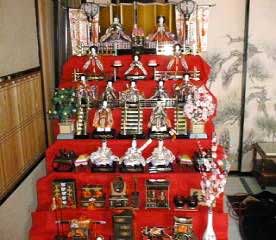 Japanese traditional instruments.For example,Fue,Taiko,Yumi,Nobori,Sensu Japanese traditional instruments.For example,Fue,Taiko,Yumi,Nobori,Sensu |
|
|
|
|
|
|
|
|
|
|
|
pachinko tuu...game judi..
kedai pachinko bising ngan muzik..
bukan senang nak menang game nih...buat perabih duit aderlaaaaa... |
|
|
|
|
|
|
|
|
|
|
|
boku no shiawase nan desu(kebahagiaan kepunyaan/milik saya)
shiawase tuh means bahagia ek.....(nih...btulllll)
susah giler...(tottemo muzukashi)
tottemo muzukashi....??? taihen plak cam ne...??(taihen pun membawa maksud yg sama)
*tak pasti..nanti saza tanya kawan japanese..kalo cakap skang jadik ajaran sesat lak..
'saya'.....ore...atau orewa.....hanya digunakan oleh budak lekaki jek..pompuan tak elok guna perkataan cam nih..cam kasar sgt bunyinya..
pas tuh...sedap---> oishi....
amai -->> manis.....kan..??(btul laaa)
ari tuh maser nengok mukodono 2003....nagase sebut...
sedap....mai..mai...mai.... macam tuh ke..?boleh ek?
(mungkin u salah dengar...sebenarnya dia sebut 'umai' yg bermaksud sedap..sama gak ngan oishi)
lagi satu nak nanyer....
wakarimashta.....(saya sudah paham)
wakatemas ---> saya faham(salah tuuu...wakatte imasu..digunakan bila bercakap ngan org atasan cam bos..atau cikgu..PM..ahli politik)
wakateru ---> saya faham gak...(wakate iru..sama gak ngan wakate imasu..cuma nih utk perbualan ngan kawan2 jek)
masaka....??sona koto....??(biar btul...menda tuuu)
*selagi saza leh jawab ..saza akan jawab ler..kalo tak leh sorry yek..:bgrin:
[ Last edited by hirai_saza on 6-10-2004 at 06:26 PM ] |
|
|
|
|
|
|
|
|
|
|
|
ok dah dapat jawapan..utk muzukashii dan taihen
muzukashi
1. difficult; hard
(a) muzukashi bun [a difficult passage]
(b) muzukashi byouki [a serious case [illness] ]
(c) muzukashi tenki da [The weather looks very doubtful. ]
(d) kono mondai wa muzukashi kute tokenai [This problem is too 「difficult for me to solve [much for me]. ]
2 troublesome
(a) muzukashi tetsuzuki [a troublesome procedure]
(b) muzukashi nen goro no shounen [a boy at a difficult age]
(c) sonna ni muzukashi ku kangaenakutemo ii [You needn't take it too seriously. ]
(d) sonna koto wo wuru to jitai wa masumasu muzukashikunaru [It will make the situation more delicate.]
3.sullen;hard to please
(a) muzukashi kao wo suru [look 「displeased [glum / sullen] ]
(b) muzukashi hito da [He is hard to please. ]
(c) kare wa tabemono ni muzukashi [He is 「particular [fussy] about his food.]
(d) muzukashi kao wo shite kanngae kon de ita [He was lost in thought with a serious look on his face ] |
|
|
|
|
|
|
|
|
|
|
|
[taihen]
1. terrible;《口》awful
(a) taihen na taihu [It is blowing very hard. / There's 「an awful [a terrible] wind. ]
(b) hiyou ga taihen darou [It will cost a lot. / It will be very expensive.]
(c) kore dake no hitobito no shokuji wo maikai youi suru no wa taihenda[It is 「a lot of trouble [no easy matter] to prepare three meals a day for all these people.]
2.serious; grave
(a) kimi wa taihen na koto wo shite kureta ne [Now you've done it! ]
(b) cici ni moshimono koto ga attara taihen da [What if anything should happen to Father!]
(c) sonna koto wo shitara taihen da [If you do that, it will have serious consequences. ]
3. very
(a) taihen shitsure itashimashita [I am 「very [《口》awfully] sorry. ]
(b) taihen ureshi desu [I am very happy] |
|
|
|
|
|
|
|
|
|
|
|
MadaMadaDane
*taihen muzukashi [terlalu susah]...pun boleh guna... |
|
|
|
|
|
|
|
|
|
sofia This user has been deleted
|
Originally posted by hirai_saza at 6-10-2004 06:03 PM:
 Japanese traditional instruments.For&# ... Japanese traditional instruments.For&# ...
bukan ker ada patung2 yg besar2 located macam kat dia punya temple or rasanya masa diaorg punya perayaan?
setiap perayaan kat jepun tu ada patung as dia punya symbol?
menarik tul gambar2 yg saza post...instrument tu macam kecik jer boleh ker main? |
|
|
|
|
|
|
|
|
|
|
|
Originally posted by sofia at 7-10-2004 09:22 AM:
bukan ker ada patung2 yg besar2 located macam kat dia punya temple or rasanya masa diaorg punya perayaan?
setiap perayaan kat jepun tu ada patung as dia punya symbol?
menarik tul gambar2 ...
tak leh main...wat hiasan jek...:bgrin: |
|
|
|
|
|
|
|
|
|
|
|
ok...sebenarnya...jepun nih lain skit..
walaupun budha tapi tuhan diorang banyak...tuhan tetek,tuhan,kot*,tuhan meja..etc..
Kami
The term KAMI can refer to gods, goddesses, great ancestors, and all variety of spirits that inhabit the water, rocks, trees, grass, and other natural objects. These objects are not symbols of the spirits -- rather they are the abodes in which the spirits reside. The abode of the kami is considered sacred, and is usually encircled with a shimenawa (rope festooned with sacred white paper).
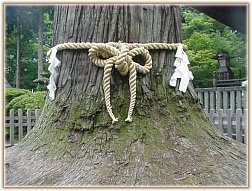
INARI or Oinari or Oinari-sama
Shinto God/Goddess of Rice and Food
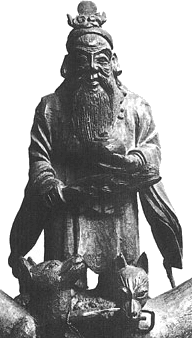
Inari, the god of rice, is a major Shinto deity. Closely associated with the Shinto goddess of food, Inari can be depicted in either male or female form. Inari not only protects the rice harvest -- s/he is also the patron of prosperity for farmers and merchants, especially those involved in rice production, foodstuffs and fisheries. Inari's messenger is the magical shape-shifting fox, and a pair of foxes typically flank Inari's image in artwork of the deity.
Inari lore is quite complex and confusing. In early records, Inari is identified with Uga no Mitama no Kami, the Shinto goddess of agriculture, and also with a male counterpart named Uka no Mitama no Mikoto (the deity of grains, fathered by Susanoo?).
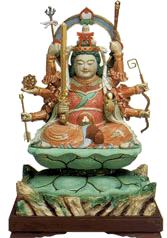 Uga Benzaiten Uga Benzaiten
Inari is also associated with the food goddess Ukemochi no Kami (aka Ogetsu hime no kami). Ukemochi and Ogetsu appear in the literature of the early 8th century. Despite their different names, the two share common attributes and are probably manifestations of the same deity. One tradition says that Inari was married to Ukemochi / Ogetsu. When she was killed by the moon god Tsuki-yomi, Inari stepped in to replace her as protector of the rice crop.
The situation gets more confusing, for depictions of Inari vary greatly. Pre-modern artwork depicts Inari as a bearded man standing on a sack of rice with two fox flanking his sides, or as a long-haired woman carrying sheaves of rice or riding a white fox (myobu). In modern times, Inari's female side has been bundled together with that of the goddess of fine arts, Benzaiten, the only female among the popular Seven Lucky Gods. The composite deity is called Uga Benzaiten.
[ Last edited by hirai_saza on 7-10-2004 at 12:35 PM ] |
|
|
|
|
|
|
|
|
|
|
|
OTHER LEGENDS ABOUT INARI'S ORIGIN
Says "Japan as It Is: A Bilingual Guide," published by Gakken, 1990:
Formerly a god of cereals worshipped in Fushimi on the outskirts of Kyoto, Inari was later merged with the Buddhist guardian deity Dakini who was generally depicted riding a fox. This and the traditional reverence of the common people for the fox are probably behind Inari's close association with the animal. Miniature Inari Shrines marking sacred sites are common. They are distinguished by their smallness, bright red gates (torii), and fox figure or figures. Deep-fried bean curd, abura-age, is thought to be a favorite food of the fox. <end excerpt>
Dakini is a powerful Buddhist goddess from the Vajrayana (Tantric) tradition, who is sometimes associated with the Hindu goddess Kali. Called the Goddess of Life's Turning Points, Dakini is today worshipped mainly in Tibet, and she can come in multiple manifestations. Dak (Sanskrit) means to beckon with sound, to call, to knock. Ini (Sanskrit) is attached to word stems to indicate female gender. Another similar theory is that Inari was syncretized with "Dakini-ten." In Japan, Dakini-ten are the various manifestations of Dakini, and were generally associated with Daikoku-ten (Mahakala), who is considered the Hindu god of the Five Cereals (later becomes god of Buddhism, and today is one of Japan's Seven Lucky Gods). This dakini had as its "messenger" a white fox, and worshippers offer fried soybean curd at Inari shrines, for this is apparently the favorite food of the fox. |
|
|
|
|
|
|
|
|
|
|
|
THE FOX SPIRIT
By the 11th century, for reasons hard to discern, Inari becomes intricately associated with the fox. In Japan, the fox is a legendary creature with supernatural powers for doing both good and evil. Able to transform into human shape (typically that of a bewitching woman), and to hear and see all secrets of humankind, the fox is Inari's messenger. Even today, fox statues are found in great number inside and outside the thousands of Japanese shrines dedicated to Inari (some 20,000 Inari shrines nationwide). Although the lore of fox magic was introduced to Japan from China and Korea, it originated in India. Nonetheless, the supernatural powers of the fox are not exclusive to Asia, for fox mythology exists -- quite independently -- in many non-Asian nations as well.
   Inari Shrine (stone) at private home in Kamakura Inari Shrine (stone) at private home in Kamakura
Inari Shrines are invariably guarded by statues of foxes |
|
|
|
|
|
|
|
|
|
|
|
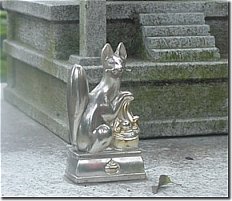 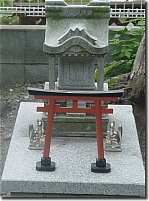
Why the Fox Connection?
According to Kasama Inari Shrine
In ancient Shinto, the "mountain kami" was believed to descend from its winter residence in the mountain to become the "paddy field kami" (ta no kami) in the spring, residing there during the subsequent agricultural season. Following the fall harvest, the deity would return once again to its winter home in the mountains in its role as the "mountain kami." All this probably took place at the same time that foxes appeared each season. As such, the fox naturally became known as the messenger of Inari.
According to Tim Screech
Once very common throughout Japan, foxes were nevertheless seldom seen since they moved at night; dead birds, broken fences and chicken's blood were the only evidence of their nocturnal passages. It may have been the difficulty of seeing a fox, or of keeping it in view for any period of time, which led to the notion that they undergo actual physical shift. A fox might skulk into the farmyards looking like a fox, but exit in an entirely different form -- as an old woman, a boy, a demon, or a princess. In Japanese lore, they live a sort of mirror image of human society, with fox lords and ladies, servants and laborers -- standing on hind legs, dressed in human clothes, and carrying out their mystic rituals by lantern light in the middle of the forest. To the end of mitigating the powers that these worrisome animals possessed, shrines were erected, and the fox-god, Inari, became the most popular roadside divinity, honored with a clap of the hands on passing by, or with a gift of flowers, sake, or fried tofu (aburage, believed to be a favorite food of foxes). Even today, it is common to see a little street-corner shelter with a ceramic fox image housed behind a grill, offerings carefully placed in front to ward off all dangerous eventualities. Foxes have to be placated, for they are potentially disastrous to the livelihood of the farmer. They are also constant and salutary reminders of the fox-like characteristics that lie at the root of human behavior as well. |
|
|
|
|
|
|
|
|
|
| |
Category: Belia & Informasi
|